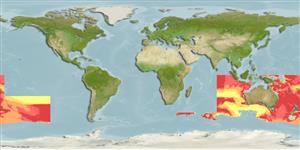Klassifizierung / Names
Namen | Synonyme | Catalog of Fishes(Gattung, Arten) | ITIS | CoL | WoRMS | Cloffa
Elasmobranchii (Haie und Rochen) (sharks and rays) >
Carcharhiniformes (Ground sharks) >
Pentanchidae (Deepwater catsharks)
Etymology: Apristurus: a-, Latin privative, i.e., without; pristis, from pristes (Gr.), sawyer (but here meaning saw); oura (Gr.), tail, referring to absence of saw-toothed crest of enlarged dermal denticles along upper edge of caudal fin as found in the closely related Pristiurus (=Galeus). (See ETYFish); australis: Latin for southern, referring to its distribution in the southern hemisphere around Australia. (See ETYFish).
Environment: milieu / climate zone / depth range / distribution range
Ökologie
seewasser bathypelagisch; tiefenbereich 486 - 1035 m (Ref. 76943). Subtropical
Indian and Pacific coasts of Australia.
Length at first maturity / Size / Gewicht / Alter
Maturity: Lm 50.0, range 45 - 55 cm
Max length : 61.6 cm TL Männchen/unbestimmt; (Ref. 76943)
Kurzbeschreibung
Morphologie | Morphometrie
This species has the following characters: flattened prenarial snout, apparently longer than interorbital width; furrows of upper labial much longer than the lower ones; pectoral fin widely expanding posteriorly, with outer margin a little longer than P1-P2 space; short abdomen, P1-P2 space narrower than preorbital length or anal fin base length; origin of first dorsal-fin just above or slightly anterior to pelvic-fin insertion; 50–64 and 48–68 tooth rows on upper and lower jaws, respectively; teeth with 5 or more cusps, including the anterior ones; egg capsule with no coiled tendrils on anterior and posterior ends, posterior end tapering toward tip; color preserved in alcohol is uniformly pale brownish to light greyish, sometimes light yellowish brown; the dorsal side of body is a little darker than ventral side (Ref. 76943).
Life cycle and mating behavior
Geschlechtsreife | Fortpflanzung | Ablaichen | Eier | Fecundity | Larven
Sato, K., K. Nakaya and M. Yorozu, 2008. Apristurus australis sp. nov., a new long-snout catshark (Chondrichthyes: Carcharhiniformes: Scyliorhinidae) from Australia. pp. 113-122. In Last, P.R., White, W.T. & Pogonoski, J.J. (eds.): Descriptions of New Australian Chondrichthyans. CSIRO Marine and Atmospheric Research Paper No. 22. (Ref. 76943)
IUCN Rote Liste Status (Ref. 130435)
Bedrohung für Menschen
Harmless
Nutzung durch Menschen
Mehr Information
Alter/GrößeWachstumLänge-GewichtLänge-LängeLängenhäufigkeitenMorphometrieMorphologieLarvenLarven Pop.Dyn.RekrutierungDichteBRUVS
ReferenzenAquakulturAquakultur ProfilZuchtlinienGenetikElectrophoresesVererbbarkeitKrankheitenVerarbeitungNutrientsMass conversion
PartnerBilderStamps, Coins Misc.LauteCiguateraGeschwindigkeitSchwimmstilKiemenoberflächeOtolithsGehirngrößeSehfähigkeit
Tools
Zusatzinformationen
Download XML
Internet Quellen
Estimates based on models
Preferred temperature (Ref.
123201): 2 - 8.7, mean 6.7 °C (based on 238 cells).
Phylogenetic diversity index (Ref.
82804): PD
50 = 0.5000 [Uniqueness, from 0.5 = low to 2.0 = high].
Bayesian length-weight: a=0.00355 (0.00176 - 0.00714), b=3.09 (2.91 - 3.27), in cm total length, based on LWR estimates for this (Sub)family-body shape (Ref.
93245).
Trophic level (Ref.
69278): 3.9 ±0.4 se; based on size and trophs of closest relatives
Widerstandsfähigkeit (Ref.
120179): sehr niedrig, Verdopplung der Population dauert mehr als 14 Jahre. (Fec assumed to be < 10).
Fishing Vulnerability (Ref.
59153): Moderate vulnerability (45 of 100).
